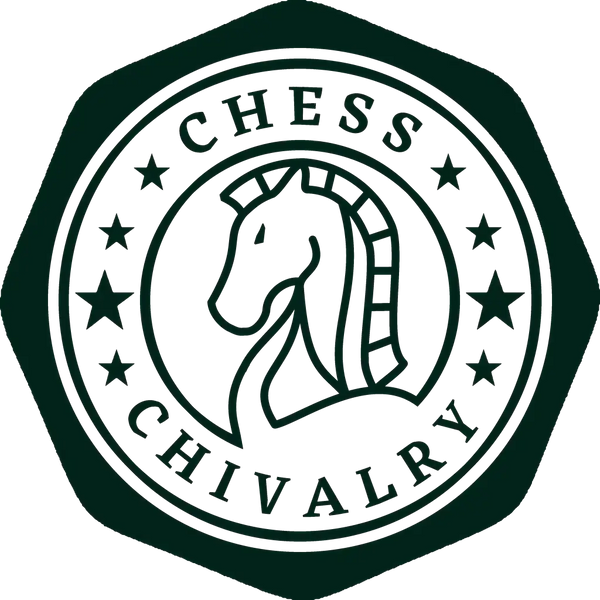
Chess & History: The Origin of The Chessboard
Share
It is a board that means the world to many people. The chessboard. A game system made up of 64 squares arranged in an 8 x 8 grid. And it is far more than just the ground for a number of historical games. It is also of mathematical importance and, with the right eye, reveals a whole new view of the mechanics of chess. In this article I want to give you an overview of its historical origins and an insight into the mechanics taking place on 64 squares.

Drawing of the starting positions in chess from the "Cyclopedia of Valuable Receipts" by Henry B. Scammell, 1897
The Origin of the Chessboard
Even if it is only a myth, the rice grain legend is considered to be the first indication of the origin of chess and thus also of the chessboard. According to this legend, the wise Brahmin Sissa, who lived in India, created a game to show his tyrannical king how dependent a ruler is on his subjects and how he cannot do anything without them. He called this game chess. The tyrannical king - his name was Shihram - was very impressed by the game and had it sent out in all directions of the sky. Through the knowledge gained from the game of chess, he also gained reason and mildness, which made him a better ruler. In gratitude, he granted Sissa a wish. He wished for grains of rice. He wished for a quantity of rice grains that would double from chess square to chess square until all the squares of the chess board were filled. The king was astonished because he underestimated the amount. But he instructed his treasurer to get the required quantity. After calculating the required amount, however, the treasurer had to inform him that the kingdom did not have enough grains of rice. About 730 billion tons of rice would have been needed. And so the king learned another lesson that would show him his power of judgement. Even though the geographical origin of the legend is not attested in Indian sources, Arabic writings refer to India as the setting of the story.
The earliest and actual mention of a chessboard-like board comes from the Indian game of Ashtāpada. Like chess, this consisted of an 8 x 8 squares, which was called Ashtāada. Unlike chess, however, it only had squares of the same colour and so-called castles were marked on the board, on which playing pieces could not be captured. Another game variant could also be played on a 10 x 10 board and was called Daśapada. A smaller game variant on a field of only 5 x 5 squares was called Chomal Ishto and was played with shells as pieces.
The exact rules of the Ashtāpada game have not survived. Some writers have assumed that it was a kind of racing game to win and recapture the marked castles and that the game was played clockwise and counterclockwise on the playing field. The assumption is based on records that suggest that dice were used for the movement of the pieces. Critics, on the other hand, consider such a method of play unlikely, as the mechanics of the game would be very confusing in relation to surviving materials. Unfortunately, it will no longer be possible to determine what is true, unless a well-preserved game should happen to turn up. The similarity to chess is obvious, however, and the direct successor to Ashtapada is considered to be one of the predecessors of chess, even according to current findings: Chaturanga or Chatrang.
Chaturanga, also called Chatrang in Persian, is the direct predecessor of the game Shatrandsch and already showed the first game pieces that have a social and military reference. Chaturanga translates as "four arms" and refers to the troops of the Indian army of the time: infantry, cavalry, war elephants and chariots. The playing field was similar to the Ashtāada and also had 64 squares divided into an 8 x 8 grid. Unfortunately, the movement patterns of the game pieces for Chaturanga have not survived completely either, and the few explanations that do exist are similar to chess but often contradictory. In the 11th century, a game variant for four players called Chaturaji was documented. In contrast to the two-person game, dice were used instead of free piece movement in this game. Whether different colours were used for the squares is also not known.

Game set-up for Chaturaji, on an Ashtāada with Chaturanga game pieces (R. C. Bell, Board and Table Games from Many Civilizations, 1980, p. 53)
From Chaturanga or Chatrang, the successor Shatrandsch developed in the 7th century. Even though the rules in this game differ from today's chess, the similarities are unmistakable. Only the special rules and the movement patterns of today's queen and bishop showed clear differences. It was also Shatrandsch that reached Europe between the 10th and 11th centuries and laid the foundation of modern chess. Records from the 14th century still show that the playing field was not necessarily multicoloured, although the typical black-and-white pattern was already occasionally present in historical writings.
Towards the end of the 15th century, rule changes such as the introduction of the double pawn move, castling and new movement patterns for bishop and queen, brought the game to its present state: modern chess. Records now generally used the multi-coloured pattern and tactical analysis of games also increasingly made reference to the square colour. In particular, the binding of the bishop to its square colour and the constant change of the square colour from the knight were topics that provided assistance for one's own play. Even if this representation did not change the actual game, it at least simplified the assessment of the current piece position. The players could now use the colours of the squares to assess the value of the opponent's bishop in relation to their own king's position or the influence the pawn structure could have on the further course of the game. The following is a more detailed explanation.
Evaluation of the Opponent's Bishop

The bishop is aiming at the king, which is still in a safe position
In this example, the black bishop is aiming at the white king. Although the latter is safe and protected by his pieces, the white player must realise that the opponent's bishop poses a greater danger and has an increased value as long as he can attack the king in the course of the game. So sooner or later the question arises here whether White moves the king and loses tempo, or captures or at least displaces the bishop. Based on the colour of the square, the white player can judge early on from the structure of the chessboard that the opponent's bishop on the black square has a higher value in the current situation than the bishop on the white square.
Evaluation of the Own Bishop

The own bishop is weakened by the own pawn structure
This example shows that even a seemingly stable pawn structure can have its advantages and disadvantages. The structure forms a closed centre and the own pawns occupy the black squares. This leads to the fact that the own bishop is blocked on the black squares and thus its value for the offensive is reduced. The bishop is virtually inactive and can only be passively activated as a defender of the pawns. Although this is not completely worthless, it represents a redistribution of value from the bishop to the pawns. The tactical benefit, on the other hand, lies in the trading of pieces. If the bishop does not find its way into the game in the long run, it could serve as a sacrifice to surprise the opponent. An exchange with a higher-value knight would also make sense, should said knight move to the kingside into the attacking squares of the restricted bishop. The structure of the square colours can also be used as an assistance to encircle opponent's bishops, be it by blocking pawns or attacking the respective square colour. A well-defended field colour can thus represent the equivalent of a bishop under certain circumstances.
The Tactical Value of the Chessboard Squares
Even if the tactical assessment of the course of the game on the basis of the field colours seems trivial, it offers a lot of potential for analysis. Apart from the examples mentioned above, thinking patterns according to colours can certainly lead to time savings in endgames or offer assistance in deciding strategy. Mating patterns can also show colour combinations that can be used for orientation. Furthermore, the colour of the square also has cosmetic reasons, of course, and offers orientation when setting up the starting positions of the chess pieces. Each player's side always has a black square at the bottom left and a white square at the bottom right. In the starting position, the queen always stands on the square of her own colour, while the two bishops occupy opposite square colours.
However, in addition to the pure visual appearance, many chess boards also have row and line inscriptions, which allow the notation of chess moves as coordinates. The lettering on the chessboard that is known today - viewed continuously from the white player's point of view - records the letters a to h on the transverse axis and the numbers 1 to 8 on the vertical axis. The chess notation based on this is in an algebraic representation, which, however, only became established in the course of the 20th century and through recognition as a standard by FIDE. Previously, moves were explained descriptively, which did not necessarily require markings on the chessboard. In smaller and amateur tournaments, labels are usually used on chess boards to minimise notational errors. In major tournaments played on electronic chess boards, there is no handwritten notation in order to keep the participants' concentration focused on the game.

Chess set with plastic chess pieces and a vinyl chessboard with coordinate notation
Common Materials for Chessboards
Chess boards in the form of mats on a plastic or vinyl base are often used, especially at larger playing events or in training sessions. These are very suitable for holding a larger number of chess games at the same time at low procurement costs. They are also easier to transport. The classic, however, is the wooden chess board. With a variety of different coloured woods, the chess board can be reproduced in a traditional and sustainable way and can be matched with the wooden carving of chess pieces. Woods that are suitable for chessboards and depict a wide range of colours are usually maple, mahogany, walnut and wenge. The classic black of a chessboard is created for most boards by the stain process, also called ebonisation. Here, the wood takes on a black hue through the chemical process of staining the surface of the wood. Alternatively, it is also possible to use rare types of wood such as the trunk wood of ebony plants, which naturally has a black colour.
I hope that I have been able to give you some interesting background on the chess board, some of which you can use in your own game analysis.
If you are interested in a chessboard, feel free to check out my selection of tournament sized wooden chessboards.
I wish you a lot of fun with the game, much success and rapid progress in your learning.
See you soon.
Stefan
